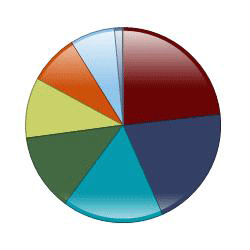 The number one thing that Exchange-Traded Funds (ETFs) have going for them is that they have lower costs and a lot of flexibility in buying and selling them. An ETF is often thought of as a mutual fund that can be traded like a stock or a bond and this is where a savvy investor can profit from trading an ETF against a basket of its component stocks. Let’s consider an example of a fictional ETF called “U.S. Big Bank Fund” or UBF, to illustrate how this would work. Assuming, UBF's component stocks are Citigroup (NYSE: C), Wells Fargo (NYSE:WFC), JP Morgan Chase (NYSE: JPM) and Bank of America (NYSE: BAC). One of the best things about an ETF is that it saves a lot of time for a trader. There is a lot of due diligence that an individual investor would have to do on the component stocks. But when investing in the ETF UBF, all investors have to do is to look at the big picture on how markets and sectors are performing. Otherwise there will be a lot of initial and ongoing due diligence that will need to be done on the component stocks of Citigroup, Wells Fargo, JP Morgan Chase and Bank of America. ETFs also tend to be cheaper to own and there can be less trading costs associated with them. It will be more profitable to trade UBF than to keep buying and selling the component stocks in the basket. There are ETFs that trade commission-free and these are great ways to get started trading. I started off like this too trading the Schwab ETFs, the iShares ETFs and the 64 Vanguard ETFs. The most important thing about ETFs is the instant diversification that they offer an investor. 10 ETFs would do a great job in diversifying your portfolio as opposed to just 10 stocks. The ETF UBF only gives exposure to big bank stocks, but in reality, ETFs are more complex and even track the S&P 500 and other stock market indexes. ETFs offer diversification at a lesser cost and they are also tax efficient when compared to just holding the component stocks. The thing about diversification in an ETF is that it enables the investor to focus on stocks in sectors that he or she prefers. This is as opposed to an otherwise diversified portfolio that contains stocks in sectors that the investor does not necessarily like but has to hold to keep the portfolio diversified. Sophisticated investors will know that it is possible to profit considerably from pair-trading. The strategy behind pair-trading is to profit from the chances of two stocks in a basket moving in opposite directions that are otherwise similar to each other. In the case of UBF, Wells Fargo could be bought because it is expected to perform better and Bank of America may be shorted since a decline in fortunes is anticipated by an investor. This strategy can be used to profit from the fortunes of whole industries through pair-trading in ETFs and in this instance UBF. The reason why ETFs are so profitable is because professional money managers have picked these ETFs and they usually perform better than the average individual investor does. But it must be stated here that most professional money managers tend to underperform when compared to average stock market returns. ETFs do come with a management fee, which should be more than offset by the savings on commissions. A full-service brokerage account would see a considerable savings in commissions. A lot of investment advisors tend to be wary of ETFs for this very reason. ETFs are tax-efficient for the simple reason that they have a lower capital gains tax liability. The basket of component stocks will see a lot of trading activity as the market tends to be dynamic and investment decisions keep changing too. But this is not the case with an ETF that holds a large number of stocks in a portfolio. There is a lot of sophistication that ETFs bring to a portfolio. ETFs enable investment strategies to be implemented with ease. There is a whole host of these strategies that can be done to profit from trading an ETF such as tax loss harvesting, portfolio insurance, risk budgeting and enhanced index strategies. It must be stated here that being successful at ETF investing requires sophisticated investing skills. Risk is very important to understand and a lot of knowledge can be picked up at the expert risk and finance resource website Bionic Turtle. Other things that need to be looked at are portfolio management techniques and market indexes. But the good thing is that ETF investing will make you a better investor and this will pay dividend. The best way to get started in ETF investing is with index investing. ETFs that mirror the Nasdaq 100 or the S&P 500 are great places to start. There are also ETFs that cover key market sectors such as healthcare, biotechnology, banking and emerging economies. Active trading of these ETFs in your portfolio will see to it that you will profit the most. Remember that with an ETF you are now trading a whole market or market sector like UBF and this is the big advantage. The bottom line is that there is no perfect investment. ETFs are a cost-effective way to have a portfolio that is broadly-diversified. But the criticism is that ETF investing only benefits large asset and fund managers. The other drawbacks when compared to trading the component stocks are that the bid-ask spread can be large, trading costs can be higher and the dividend yields can be lower in an ETF. Nonetheless, ETFs are soon going to be a part of every investor's portfolio because they are better than mutual funds, which are also very popular among investors. comments powered by Disqus |

|
|
|
|







